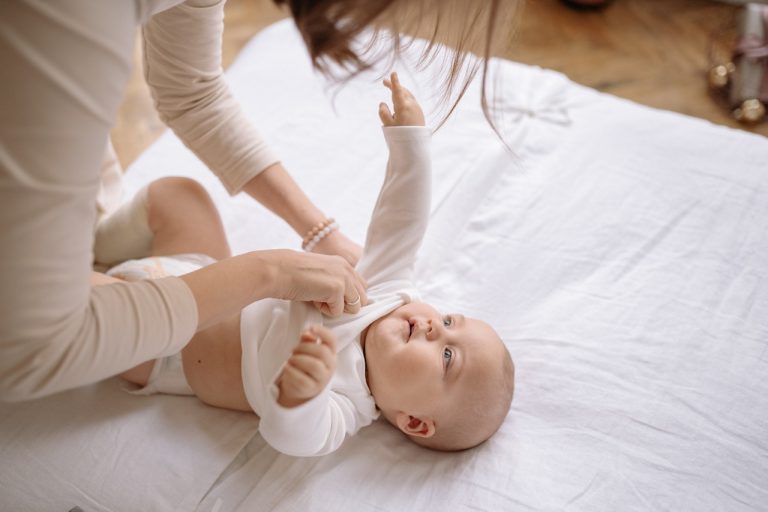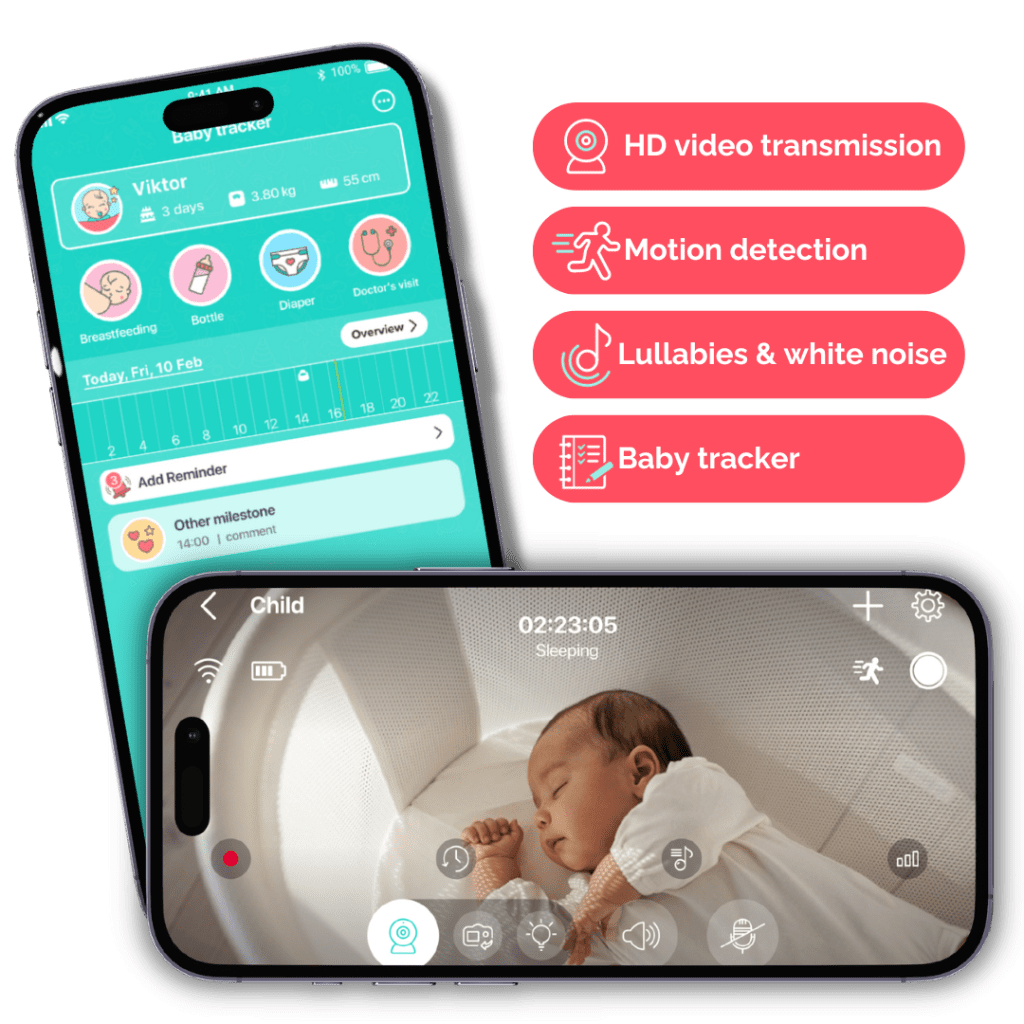
How To Dress Your Baby for Sleep: The Ultimate Baby Clothing Guide for Safety and Comfort
- Created:
11. 10. 2023 - Updated:
8. 11. 2023
Newsflash:
Although it seems like a simple task, parents can testify that dressing a baby for sleep requires utmost care.
And this isn’t just because of babies’ fuss when it’s time to change.
Generally:
Babies need comfort and safety while sleeping, and their outfits are crucial in ensuring they stay cozy.
With that said:
In this article, we’ll discuss how to dress your baby for sleep in various conditions to ensure safety and comfort.
Let’s begin.

How Room Temperature Affects Your Baby’s Sleepwear
Check this out:
The temperature of your baby’s sleeping environment affects the kind of clothes they should sleep in.
That’s right!
The thumb rule for nighttime sleepwear is to dress your baby according to the temperature.
According to Healthline, the recommended room temperature for a baby to sleep is between 68°F (20°C) and 72°F (22.2°C).
Furthermore:
The American Association of Pediatricians (AAP) doesn’t give a specific room temperature range for baby sleep. Rather, it recommends adjusting the baby’s sleepwear with change in temperature.
Let me explain:
The goal of dressing your baby according to the room temperature is to balance out the external temperature.
To do this, you must first determine how low or high the temperature of their sleeping environment is. Then, dress the baby in clothes that bring their temperature to the recommended level.
So:
In cold temperatures, adding more clothing layers like blankets or sweaters is best to keep them warm. And in hot temperatures, dress them in lighter clothes.
Essentially:
Knowing how to dress your baby according to the temperature keeps them comfortable and prevents Sudden Infant Death Syndrome (SIDS).
Seasonal Sleepwear Choices
As expected:
The seasons affect your baby’s sleeping room temperature.
On the one hand:
The room temperature is typically cold in the winter, especially if you don’t have a heating system.
On the flip side:
The room temperature is much higher in the summer.
These temperatures could negatively or positively affect your baby’s sleep, depending on how well you manage them.
Thus:
Just like in cold and hot situations, there are sleepwear choices suited for various seasons. Thick sleepwear is advisable for cold seasons, while light sleepwear is best for warm to hot seasons.
For example:
The ideal sleepwear for cold winter nights is a full suit with a wearable blanket layered over it. And for the hot summer months, onesies, light pajamas, or just their diaper would suffice.
Pro tip:
Depending on how cold it gets, you might also have to clothe your baby in mittens and get a heating machine for their room. This machine can help increase low temperatures on cold winter nights.
On another note:
During transitional seasons like spring and fall, stick to thin layers unless their room temperature is low.
If the temperature is low in spring, you can opt for thicker clothing like a cardigan over a onesie.
Additionally, you should always opt for cotton sleepwear during summer and transitional seasons like spring and fall.
Age-Appropriate Sleepwear Choices
Get this:
Your baby’s age is one of the factors to consider when choosing sleepwear.
You read right!
As your baby grows, just as they experience nap transitions, they also transition from one type of sleepwear to another. And not knowing what kind of sleepwear is appropriate for a baby’s age could place that baby at risk of SIDS.
In essence:
For newborns, their sleepwear should be lightweight and preferably cotton material, which has less risk of causing them to overheat.
However:
As the baby grows older, they can start safely transitioning to thicker sleepwear. The following are the baby milestones for transitioning to different types of sleepwear:
- Newborns (0-3 months): The best sleepwear for newborns are cotton footed onesies or rompers, swaddled or in a sleeping sack. And the recommended room temperature is between 73.4°F (23°C) to 77°F (25°C).
- Infant (3-12 months): The rules for selecting their sleepwear are still similar at this stage. You should clothe your infant in fire-resistant onesies, socks, and swaddles.
- Toddler (1-3 years): At this stage, the risk of SIDS is greatly reduced, so the baby can cover up less to sleep. But, if their sleep environment is cold, the long pajama pants, a long-sleeved top, and socks would suffice.
Types of Sleepwear for Hot and Cold Conditions
As we’ve mentioned:
Room temperature is vital to consider when dressing your baby for bed.
In fact:
There are specific types of sleepwear suited to both hot and cold conditions. These clothing items help your baby get comfortable and safe sleep.
With that in mind:
To help you find the right clothing for your baby’s sleep, below, we’ll describe some types of sleepwear for hot and cold conditions:
1. One-Piece Sleepers
For starters:
One-piece sleepers, such as onesies and footed onesies, are sleep outfits that cover the baby’s whole body, including their legs.
Unsurprisingly:
These sleepwear are most appropriate for cold situations, especially thick one-piece sleepers. They cover the baby and prevent them from catching a cold.
Some more benefits of one-piece sleepers include:
- They provide more comfort to the baby since they’re cozier.
- They reduce the wash load because they’re just a single clothing unit.
- In extremely cold situations, you can easily layer other pieces of clothing since they wrap snugly around the baby.
- They leave room for baby mobility.
2. Two-Piece Sets
Fact:
Two-piece sets are sleepwear best adapted for toddlers. However, 6-month-olds can also wear them since they’re most effective for a quick diaper change.
But it doesn’t stop there:
Two-piece sets have multiple benefits to offer:
- They are suitable for warm to slightly hot temperatures since they are breathable and let air contact the baby’s skin.
- You can also layer them with onesies underneath during cold weather.
- They’re easy to take off.
3. Sleep Sacks
One thing’s for sure:
Sleep sacks are a sure way to ensure your baby stays warm in cold temperatures. They go on the baby like a dress with either short or long sleeves.
The only difference is that they’re closed at the bottom, hence the name “sack.”
Here’s how they work:
Sleep sacks apply warmth and gentle pressure to the baby to improve their comfort while they sleep. They’re also designed to adapt to temperature changes since they’re loose-fitting, allowing air to reach the baby’s skin.
Some benefits of sleep sacks include:
- They keep the baby warm in cold weather.
- They prevent overheating in warm to hot temperatures.
- They’re a great alternative to blankets, which aren’t advisable as baby sleepwear.
4. Swaddles
Here’s the deal:
Swaddling is wrapping your baby in a thin blanket to mimic the coziness of the womb. This action makes them feel comfortable and safe enough to fall asleep.
Now:
While swaddling your baby is safe, you have to do it right to obtain its benefits. This also includes laying your baby in the correct position to sleep on their back after swaddling.
The following are some best practices for swaddling in hot weather:
- Use a lightweight blanket made of breathable material like cotton to swaddle the baby.
- Don’t overdress your baby so they don’t get too warm.
- Keep the room cool.
Unlike the hot weather, swaddling in a cold condition has different best practices:
- Put on more layers of clothing underneath the swaddle blanket.
- Ensure the baby’s clothing isn’t loose under the swaddle.
- In extremely cold situations, you can use a sleep sack underneath the swaddle.
Remember:
Once your baby shows signs of rolling over, you should stop swaddling. The baby might roll over and lay face-first in the swaddle. This position could lead to Sudden Infant Death Syndrome (SIDS).
Practical Tips for Dressing Your Baby
Trust me:
Like everything else about babies, you need preparation when dressing your baby for sleep. It’s especially important to prepare for situations such as travel and sudden temperature shifts.
But don’t panic:
I’ll describe some practical tips for dressing your baby below:
1. Dress Them So They’re Not Too Hot or Too Cold
The truth is:
Babies aren’t huge fans of extreme temperatures.
I’m sure it’s not news.
Extreme temperatures increase the risk of Sudden Infant Death Syndrome in babies, especially those under a year old.
But here’s the trick:
Dressing your baby so they’re not too hot or cold reduces this risk drastically and ensures they are comfortable in their sleep environment.
To break it down:
In hot weather, dress your baby in fewer layers and lighter, breathable clothes. And in cold weather, clothe them in thicker layers.
This ensures your baby is safe and guarantees their comfort while sleeping.
2. Choose Close-Fitting Outfits
Listen:
As awkward as it might sound, close-fitting clothes are best for a baby’s sleepwear.
Check this out:
Extremely loose clothes make the baby uncomfortable and restrict their movement. So they won’t be able to roll while sleeping or even find comfortable resting positions.
On the contrary:
Close-fitting clothes cover your baby properly, preventing the weather from affecting them.
Not to mention:
They allow easier movement and comfort in babies.
And since you want your baby to be as comfortable as possible, close-fitted sleepwear is always the best option.
3. Prepare For Anything
Fact:
Even the slightest change in a baby’s environment could affect them. This is because their bodies haven’t fully developed resistance to extreme conditions.
So:
They feel discomfort, pain, and even stand a risk of SIDS when exposed to fluctuating conditions, whether it’s temperature or environment.
For this reason:
In scenarios where your little one has to switch environments, like in travels or sudden temperature fluctuations, you must prepare.
For instance:
While traveling with your baby, you can take extra clothing items like blankets if it gets colder. And have their sleep sacks and other sleepwear in place if you suspect they might be experiencing the effects of a changing environment.
Final Tip: Finding Baby Sleep Balance with Annie Baby Monitor
Getting to grips with a newborn’s sleep routine can be challenging.
To strike the right balance, we recommend using the Annie Baby Monitor baby tracker feature.
Keeping a tab on your baby’s sleep and feeding patterns is super important, and the baby tracker is the ultimate lifesaver for it.
The tracker helps you monitor your baby’s sleep duration and feeding times, ensuring that they are well-nourished and have enough snooze hours.

Keep an eye on your baby’s sleep routine with the Annie Baby Monitor baby tracker feature. Adjust baby schedule as needed to ensure they get the rest they need.
The Annie Baby Monitor helps you make informed decisions about your baby’s sleep patterns and keep on track for healthy development.
Conclusion
In all:
External conditions such as temperature and seasons greatly determine how to dress your baby for sleep.
However:
Aside from these external factors, age can also determine the kind of sleepwear your infant should use. The older the baby gets, the more flexible their sleepwear planning is.
When dressing your baby, it’s always advisable to:
- Dress the baby so they’re not too hot or too cold
- Choose close-fitting clothes over loose ones
- Prepare for scenarios such as travel and fluctuating temperatures
Remember:
Colder temperatures require you to dress your infant in more layers, while hotter temperatures require fewer layers.
In any case:
It’s important to prioritize your baby’s comfort and safety when dressing them for bed. This presents the risk of pain, illness, and SIDS.
And if you notice them overheating or showing more signs of discomfort, contact a pediatrician immediately.
Wrapping up:
If you found this article helpful, do leave a comment below. And don’t forget to drop your questions, concerns, and suggestions as well.






